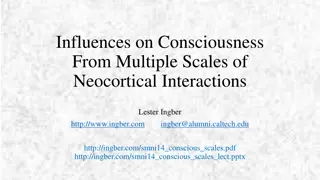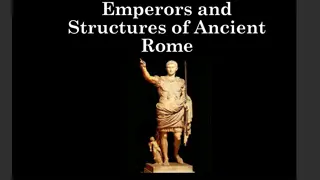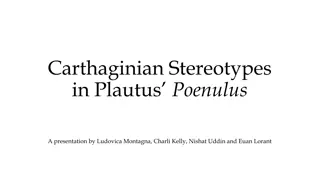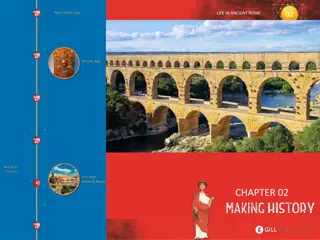Interactions and Complexity in "Rome and Carthage in the Poenulus
Rome and Carthage clash in the play Poenulus, with characters like Hanno, Agorastocles, and Milphio adding depth to the narrative. The dynamics between Roman and Carthaginian cultures, the complexity of nationality and characterization, and the subversion of audience expectations through intricate relationships are all explored in this thought-provoking theatrical piece.
Download Presentation

Please find below an Image/Link to download the presentation.
The content on the website is provided AS IS for your information and personal use only. It may not be sold, licensed, or shared on other websites without obtaining consent from the author. Download presentation by click this link. If you encounter any issues during the download, it is possible that the publisher has removed the file from their server.
E N D
Presentation Transcript
Rome and Carthage in the Poenulus Presented by Luiza Diaconescu, Lukas Hillman, Wiktor Marecki,
Hanno Carthaginian Senex lepidus stock character He lost his daughters when they were young and in the play he is searching for them Mulierosus he is womanlike/ he likes women/ both Contradictory characterization: he is presented as a trickster (as Carthaginian were often portrayed), but he also has respect for friends Considered by scholars as very pious
Agorastocles Hanno s nephew He was kidnapped, like Hanno s daughters, from Carthage when he was seven and adopted by a Greek rich man, who also happened to be Hanno s guest friend In love with one of Hanno s daughters, whom he wants to marry
Milphio Agorastocles slave He should be the Servus Callidus of the play, but Hanno appears to be more intelligent than him, in the scene in which Hanno speaks in Punic and Milo pretends he can understand the language
Roman and Carthaginian Interactions From the outset there is a sense of stereotyping, if not xenophobia the play is called Poenulus (The Little Carthaginian) a word which had deeply negative connotations in Rome; Hanno is also called Poenus There had been a treaty between Rome and Carthage for over a decade, though, after the Hannibalic war (202 BCE) and there is no mention of the Punic Wars in the play, at all If Hanno, a Carthaginian, is to be shown in a derogatory way, then why aren t his daughters and nephew depicted in the same way, too? Who is the butt of the joke in the play is it, perhaps, the audience, since the character of Hanno is so complex, and so many tropes are confounded, subverting the audience s expectations?
The Complexity of Nationality Hanno is a complex character: he seems typically Punic, but lacks duplicity and has the Roman quality of pietas Hanno has been called the most pious character in Roman literature other than Aeneas himself (Gratwick (1971) 32.) Hanno says that he would only use trickery on an enemy and that to use it on a friend is foolish (lines 1089-90) Milphio, the Roman slave, who fills the role of the Servus Callidus (Cunning Slave) is shown to be more perfidious than Hanno when they attempt to restore Hanno s daughters to him Hanno s part in the plan is based on the truth, yet Milphio tries to trick the pimp, Lycus Is Hanno perfectly Punic for outwitting both Milphio and Lycus? He pretends not to know Latin in the beginning evidence of his perfidy However, Milphio pretends to know Punic and does an awful job of translating
The Complexities of Nationality Trustworthiness as a particularly Roman virtue Orientalism defining the East by means of fantasies Pandering to a mainstream audience Twist on the usual Plautine comedic plot the main actors play people who act like native Romans, but have Greek names by the end of the play discover or disclose that they are not Greek, but Carthaginian Looking foreign were they wearing masks? What did they look like? Setting: Greece Calydon mythical We don t know what jokes the Carthaginians made about the Romans all their literary texts are gone Carthaginian reputation history written by the victors Race/ethnicity as a costume that can be put on and taken off: Adelphasium puts on Punicity and leaves behind poverty, prostitution, and lower class, and with her lover learns attributes of an imaginary upper class Play may have been performed in the Forum Romanum, on the occasion of major religious festivals
The Paradox of Hanno Is Hanno s pietas (brought up a number of times towards the end of the play) a running joke, however? The Carthaginian people were thought to have sacrificed children to their gods (Diod. Sic. 20.14) does this put a new spin on Hanno s quest? Despite using the strength of his pietas in the effort to find his daughters and invoking Jupiter to reward his piety, Hanno sleeps his way across the Mediterranean; only after sleeping with the prostitutes does he ask them if they might be his daughters. Thus, does he make a mockery of this most Roman of virtues? Could it have been funny that there was a Carthaginian behaving like a Roman one who was seemingly pious and who new Roman law? He threatened to take Lycus to court for having bought free citizens Clothing: a tunic without a pallium was thought effeminate and suggested lax morals; an unbelted tunic was a disgrace
ROMAN(?) WOMEN Concern with the growing wealth and power of Roman women 195 BC proposal to repeal the Oppian Law intended to limit wealth and display of wealth by women forbade them to wear certain garments, limited the amount of gold they could possess A parody of the Oppian debate or similar debates: exchange between Hanno s daughters: Adelphasium (learned, wise) and Anterastilis According to Livy s Cato Roman women have been corrupted by having formerly experienced luxuria et avaritia Adelphasium her refusal to spend money beyond the means of Lycus the pimp or the requirements of her profession would please and perplex her austere Roman mentor pudor (modesty and honour) as opposed to a desire for wealth Feminine concern with clothes appears in a number of other Plautine comedies as part of the feminine stereotype Anterastilis comparison of women to salt-fish Roman fondness for food
Venus of Eryx We are unsure where the Poenulus was first performed, but it may have been shown under the temple of Jupiter on the Capitoline and the temple of Venus Erycina These two deities were perhaps a way to compete with the Carthaginian deities of Ba al Hammon and Astarte; Carthage also had a temple to an Erycinian Astarte Venus of Eryx was linked to Roman victory in the first Punic War and the conquest of the first Roman province, when Hannibal s ally, Syracuse, was besieged by Claudius Marcellus in 212 BCE Hanno is like Hannibal (their names are etymologically linked) when defeated but also like the comic uncle from comedy
Bibliography Richlin, Amy. Rome and the Mysterious East: Three Plays by Plautus, University of California Press, 2005. ProQuest Ebook Central, https://ebookcentral.proquest.com/lib/warw/detail.action?docID=254865. Johnston, Patricia A. Poenulus I, 2 and Roman Women , Transactions of the American Philological Association (1974-2014), Vol. 110 (1980), pp. 143-159, The Johns Hopkins University Press, https://www.jstor.org/stable/284215 Franko, George Frederic. The Characterization of Hanno in Plautus' Poenulus , The American Journal of Philology, Vol. 117, No. 3 (Autumn, 1996), pp. 425-452, The Johns Hopkins University Press, https://www.jstor.org/stable/1561836 Henderson, John. Hanno s Punic Heirs: Der Poenulus-Neid des Plautus Writing Down Rome: Satire, Comedy and Other Offences in Latin Poetry (1999) 3-37. Oxford: Clarendon Press























